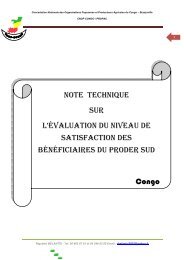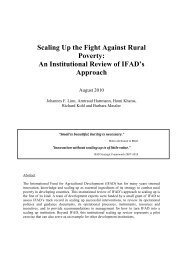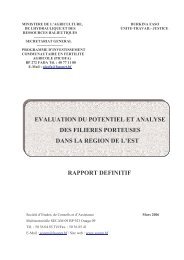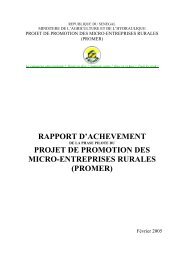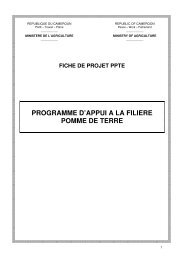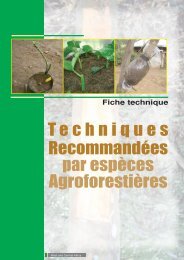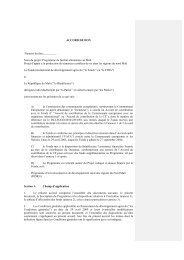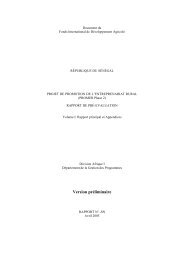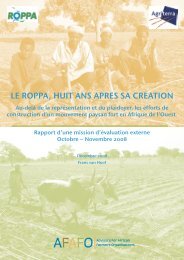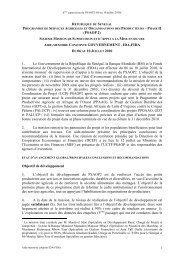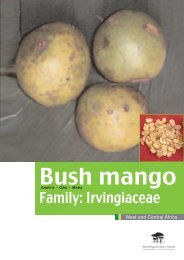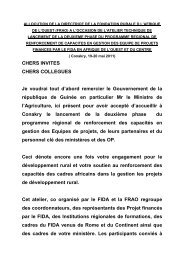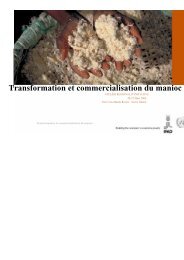CASSAVA OPPORTUNTIES IN NIGERIA - FAO.org
CASSAVA OPPORTUNTIES IN NIGERIA - FAO.org
CASSAVA OPPORTUNTIES IN NIGERIA - FAO.org
Create successful ePaper yourself
Turn your PDF publications into a flip-book with our unique Google optimized e-Paper software.
Governments. In travelling across the country it<br />
was soon realized that much of the data desired<br />
for this study of cassava had not been collected<br />
nor collated and was not readily available in a<br />
form that could be quickly or easily analysed. It<br />
was for this reason that The Nigerian Cassava<br />
Industry: Statistical Handbook 2004 was born.<br />
THE <strong>NIGERIA</strong>N<br />
<strong>CASSAVA</strong> <strong>IN</strong>DUSTRY:<br />
STATISTICAL<br />
HANDBOOK 2004<br />
THE 1ST ANNUAL<br />
<strong>IN</strong>CLUDES 2002 AND 2003 DATA<br />
WHERE AVAILABLE<br />
This handbook, a first of its kind for cassava,<br />
contains over 100 pages of data in tabular form<br />
relevant to the Nigerian cassava industry. The<br />
sections provide data on production, processing,<br />
utilization, prices, enterprise budgets,<br />
transportation, domestic economic indicators and<br />
international cassava data. The data is intended<br />
to provide a baseline for monitoring changes in<br />
the industry and a guide for investments and<br />
research. Although some tables are incomplete,<br />
sections and table headings are provided, as a<br />
guide for future industrial data collection.<br />
The Handbook is intended to provide the Nigerian<br />
Cassava Industry and those interested in learning<br />
about the industry with a basic understanding of<br />
its scope, <strong>org</strong>anization and magnitude. It is hoped<br />
that this Handbook will be updated on an annual<br />
basis and widely distributed in both hard and soft<br />
formats. Hard copies are to be made available to<br />
all levels of government, institutions, industries,<br />
associations and interested individuals. Soft<br />
copies are to be made available on request to<br />
those with available technology.<br />
Although many have suggested that such a<br />
Handbook can be easily and cheaply maintained<br />
in CD or web site form many people in Nigeria do<br />
not have access to such technology and even<br />
those that do, do not have a steady supply of<br />
electricity for it to be available when and as<br />
needed. Paper copies are still very important in<br />
2<br />
Nigeria. Especially so, when one considers the<br />
fact that less than one percent of the population<br />
accesses the Internet or has personal computers<br />
(World Bank, 2004).<br />
The Handbook should be used as a companion<br />
when reading this report. Data summarized in this<br />
report can be examined in detailed tabular form in<br />
the Handbook. It is hoped that as the use and<br />
availability of the handbook become widespread,<br />
industrial stakeholders, policy makers and<br />
national researchers will be able to undertake<br />
their own or similar analysis and interpretation of<br />
the data when and as needed. This report<br />
together with the Statistical Handbook forms a<br />
pool of information from which private sector<br />
investor information can be drawn.<br />
Another innovation brought about by this study<br />
was the development of regional production<br />
models that can be used to simulate the outcome<br />
of alternative production scenarios.<br />
1.3 REGIONAL PRODUCTION MODELS<br />
Regional production models have traditionally<br />
been used to assess the potential responses of<br />
farmers to changes in policy, technology and<br />
market conditions. Depending on the objectives of<br />
the analyses and the availability of data, the<br />
scope of such models has ranged from that of<br />
individual farms to aggregate models representing<br />
the entire agricultural industry.<br />
For this study linear programming was selected as<br />
an appropriate technique to develop regional<br />
production models. Linear programming is a<br />
technique that maximizes or minimizes an<br />
objective function subject to a set of constraints.<br />
In the case of regional modelling the objective<br />
function normally consists of maximizing profit or<br />
output from farming activities, or minimizing costs<br />
of production or use of inputs. The constraints<br />
generally refer to the availability of land and<br />
labour and the need to meet some minimum<br />
marketing, or consumption standard.<br />
These models are typically based on enterprise<br />
budgets. Ideally the budgets provide an indication<br />
of quantity and cost of production inputs, as well<br />
as the timing of these activities. These budgets<br />
also provide information on the output and value<br />
of production activities. The budgets may also



